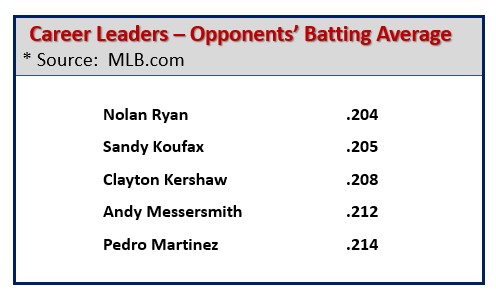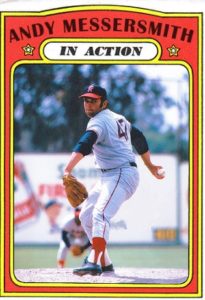It’s hard to imagine a player putting up a career average of .170 and still managing to stay in the major leagues for 11 seasons, going 86 consecutive at bats without a hit or having a 10,000-strong fan club, despite an average below the Mendoza line. Those are among the “accomplishments” of a hand full of hitters whose performance caught Baseball Roundtable’s attention. Read on for their stories.
Bill Bergen – .170 career average over 11 MLB seasons
 Bill Bergen managed an eleven-season (947-game) career as a major league backstop. He must have been doing something right behind the plate, because he had plenty of difficulty when at the plate. Over his MLB career, Bergen hit just .170 (516-for-3,028) – the lowest career average for any player with at least 2,500 MLB at bats. In only one season – 1903 for the Cincinnati Reds – did Bergen hit at least .200 (.227 in 58 games that season). Bergen also showed little power, with just two career home runs (45 doubles and 21 triples). Note: Over the span of Bergen’s MLB career, the overall MLB batting average was .253.
Bill Bergen managed an eleven-season (947-game) career as a major league backstop. He must have been doing something right behind the plate, because he had plenty of difficulty when at the plate. Over his MLB career, Bergen hit just .170 (516-for-3,028) – the lowest career average for any player with at least 2,500 MLB at bats. In only one season – 1903 for the Cincinnati Reds – did Bergen hit at least .200 (.227 in 58 games that season). Bergen also showed little power, with just two career home runs (45 doubles and 21 triples). Note: Over the span of Bergen’s MLB career, the overall MLB batting average was .253.
Bergen wrapped up is career (1901-03/Cincinnati; 1903-11/Brooklyn) with a .194 on-base percentage and a .201 slugging percentage.
In 1909, Bergen hit just .139 in 112 games. That is the lowest average ever for a batter qualifying for the batting title. (Note: Bergen would not qualify under current rules – a minimum 3.1 plate appearances for each team game played.)
Defense! Defense!
Bill Bergen was a superior defensive backstop. He led NL catchers in fielding percentage twice and in assists in three seasons. His career 1,444 assists are ninth overall. For his career, he threw out 48 percent of attempted stealers, twice leading the NL in runners caught stealing.
______________________________________________
Chris Davis – .168 average in 2018

Photo by Fort George G. Meade 
Orioles’ 1B/DH Chris Davis’ .168 average in 2018 (79-for-470) was the lowest recorded by a qualifying batter (under current rules). Davis, a noted power hitter, did pop 16 long balls and drive in 49 runs in his .168 campaign. He also fanned 192 times in 522 plate appearance (about 37 percent of his PA’s).
Davis also holds the record for consecutive plate appearances (62) and at bats (54) without a hit (by a non-pitcher). That steak began with an 0-3 game on September 15, 2017 and stretched to April 13, 2019 – when Davis broke out with a three-for-five (two doubles/four RBI) game against the Red Sox in Boston. Davis, notably, followed up is .168 average in 2018 with a .179 average (105 games) in 2019.
A Blast (or Blasts) From the Past
Chris Davis – a 6’3”, 230-pound power hitter, hit .286, with an AL-leading 53 home runs and 138 RBI for the Orioles in 2015.
In his 12 MLB seasons (Texas and Baltimore), Davis has hit .234, with 295 home runs and 779 RBI. In the four seasons between 2012-2015, he hit .256 with 159 home runs and 412 RBI – leading the AL in home runs twice and RBI once. Primarily a 1B, he has also played some 3B, OF and DH. Davis has taken the mound twice in his MLB career – tossing three innings and giving up one run on four hits, while fanning three and walking one. Davis is expected back in the Orioles’ lineup (1B/DH) in 2020.
_____________________________________________________
John Gochnaur – Consistency is not always a virtue
John Gochnaur did not distinguish himself (as least in an enviable way) on the baseball diamond. In 1903 (his last of three MLB campaigns), the Cleveland Naps’ shortstop led all of MLB in errors with 98. Couple that with his .185 batting average (zero home runs and 48 RBI in 134 games) and you can see why 1903 was Gochnaur’s final MLB season. What caught BBRT’s eye, in addition to his futility at the plate and in the field, was his consistency. Gochnaur averaged .185 in 1902 (127 games) and again in 1903 (134 games) – his two American League campaigns. Notably as a rookie for Brooklyn (NL) in 1902, he went four-for-eleven, giving him an NL career average of .364, an AL career average of .185 and an overall average of 187 – no home runs and 87 RBI.
___________________________________________________
Bob Buhl … Zero for the season
In 1962, Cubs’ pitcher Bob Buhl established a single-season record for futility – going zero-for-seventy (he fanned 36 times, but did draw one walk, drive in one run and steal one base). Notably, between September 1, 1961 and May 8, 1963, Buhl went 86 consecutive at bats without a safety. Buhl was a career .089 hitter (76-for-857, with zero home runs and 26 RBI). He also fanned 389 times in 953 plate appearances (40.8 percent).
On the mound, Buhl fared better. In 15 seasons (Braves, Cubs, Phillies), Buhl went 166-132, 3.55 – winning 15 or more games in five campaigns. For the 1957 Word Series Champion Braves, Buhl went 18-7 (a league-leading .720 winning percentage), with a 2.74 ERA.
______________________________________________________
Roy Oyler – Biggest Fan Club ever for a .165 hitter
Roy Oyler only once got enough plate appearance to qualify for the batting title, but he did last six seasons in the major leagues (1965-1970 …. Detroit, Seattle, California), playing in 542 games and putting up a .175 average in 542 games (1,265 at bats). He even hit 15 home runs and drove in 86. Oyler’s annual batting averages went like this: .186 (82 games); .171 (71 games); .207 (148 games); .135 (111 games); .165 (106 games); and .083 (24 games).
Oyler, like many light hitters, did bring a good glove to the game, but that was not enough for the Tigers to protect him in the 1968 expansion draft and Oyler found himself with the Seattle Pilots in 1969 – where he hit just .165. Still, a local disc Jockey – noting Oyler’s lack of offensive prowess – started an Oyler fan club called the “Soc It To Me .300 Club” – a play on the popular Rowan & Martin’s Laugh In phrase. The letters were an acronym for “Slugger Oyler Can, In Time, Top Our Manager’s Estimate.” (He didn’t do that, however, as the .165 average illustrates. Still, he did hit a career-high seven home runs that season.) The Oyler fan club grew to more than 10,000 members and the Pilots even had three Ray Oyler Nights at the ballpark. (The next season, by the way, Oyler was playing for the California Angels and the Pilots were the Milwaukee Brewers.)
Honorable Mention
In MLB history, there have been an unlucky thirteen campaigns in which a batter fanned more than 200 times. Mark Reynolds holds the record with 223 whiffs in 2009 and his three seasons of 200+ K’s (consecutively 2008-10) are also an MLB record. He was also the first batter to whiff 200 or more times in a season. In his three 200+ strikeout seasons, Reynolds hit .234, with 104 home runs and 284 RBI – while fanning in one of every 2.9 plate appearances. Reynolds also had two seasons in which he played least 100 games and hit under .200. Reynolds put up a stat line of .236-298-871 in 13 MLB seasons (2007-19 … Diamondbacks, Orioles, Indians, Yankees, Brewers, Cardinals, Rockies, Nationals). Reynolds, a free agent, was released by the Rockies late last July.
Primary Resources: Baseball Reference.com; Baseball-Almanac.com; MLB.com; “Pilot Shortstop Ray Oyler played only one season in Seattle and batted .165. Why was he so popular?” Seattle Times, April 4, 2019 by Bill Reader.
 Baseball Roundtable is on the Feedspot list of the Top 100 Baseball Blogs. To see the full list, click here.
Baseball Roundtable is on the Feedspot list of the Top 100 Baseball Blogs. To see the full list, click here.
I tweet baseball @DavidBBRT
Follow/Like Baseball Roundtable’s Facebook Page here. More baseball commentary; blog post notifications; PRIZES.
Member: Society for American Baseball Research (SABR); The Baseball Reliquary; The Negro Leagues Baseball Museum.



















